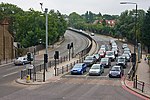Municipal Borough of Hendon
Districts abolished by the London Government Act 1963Districts of England created by the Local Government Act 1894HendonHistory of local government in London (1889–1965)History of local government in Middlesex ... and 2 more
History of the London Borough of BarnetMunicipal boroughs of England

Hendon was an ancient civil parish of around 8,250 acres (33 km2) which included Mill Hill on the border of Hertfordshire, as well as Golders Green and Childs Hill on the border of what became the County of London. In 1894 it was created an urban district of Middlesex and in 1932 it became a municipal borough. The municipal borough was abolished in 1965 and the area became part of the London Borough of Barnet.
Excerpt from the Wikipedia article Municipal Borough of Hendon (License: CC BY-SA 3.0, Authors, Images).Municipal Borough of Hendon
The Burroughs, London Hendon Central (London Borough of Barnet)
Geographical coordinates (GPS) Address Phone number Website Nearby Places Show on map
Geographical coordinates (GPS)
| Latitude | Longitude |
|---|---|
| N 51.5883 ° | E -0.2292 ° |
Address
Middlesex University
The Burroughs
NW4 4BT London, Hendon Central (London Borough of Barnet)
England, United Kingdom
Open on Google Maps









